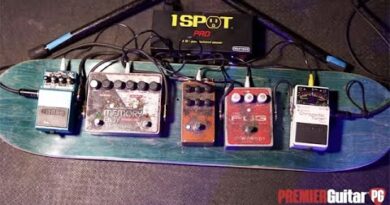How to use Drop 2 Chords on a Jazz Blues – Bebop Skill
Drop 2 chords are one of the most important types of chord voicings in Jazz, and especially when it comes to the bebop or hardbop styles. This lesson is focusing on the Drop 2 voicings on the middle string set. I played and transcribed an example on a medium jazz blues. The example illustrates how great these are for groove oriented medium swing comping.
???? Subscribe for more free Jazz Guitar Lessons and Videos: https://bit.ly/JensLessons


Sign up for my newsletter:

You can download a PDF and read the article on my blog via this link: https://jenslarsen.nl/drop-2-chords-on-a-jazz-blues/
Take your Drop2 skills further with this WebStore lesson:
If you like this video and want to help translate it into your own language you can do so here: http://www.youtube.com/timedtext_video?v=G0ttTU8QUB4&ref=share
Facebook: https://www.facebook.com/jenslarsenYTlessons
Twitter: https://twitter.com/JensLJazz
Snapchat: jenslarsenjazz
Instagram: https://instagram.com/jenslarsenjazz/
Google+: https://plus.google.com/u/0/+JensLarsen/posts/p/pub
Tumblr: http://jenslarsenjazz.tumblr.com/
My Gear:
Sono Core Vintage 13-53 Strings: http://www.sono-tone.com/products.html
QSC K10 Powered Monitor: http://amzn.to/2iPKMza
FocusRite Audio Interface: http://amzn.to/2iPKGrd
Sennheiser HD215 Headphones: http://amzn.to/2iPKqbQ
Lumix G6 Camera: http://amzn.to/2hXxBfJ
GuitarPro 7: http://bit.ly/GuitPro
GuitarPro 6: http://amzn.to/2iLCZQk
Webhosting – Siteground: https://www.siteground.com/index.htm?afcode=77f5392e5577969ff5e82a3484f8aff8
John Daw Custom picks: http://dawmanpicks.com/
#Drop #Chords #Jazz #Blues #Bebop #Skill
Originally posted by UCqepSCHTyWj4BzHxEEUNvlg at https://www.youtube.com/watch?v=G0ttTU8QUB4




What do you find the most important form to know in Jazz? The Blues, Rhythm Changes, All The Things You Are? ????
8:10 It's always Allan Holdsworth to me
He's the God of Guitars and there's so much I could learn from him
He brought chords to a next level
He also offers a lot of freedom to the people who play with him
Pat Methany
I don't agree with this kind of jazz teaching it's 5min of talk and 5sec of I show you the chords, just show us how it's used in songs already and practical material to use like progressions. people may spend 1h on this an learn nothing usable at the end.
I want to hear music it's stuff I will remember, no chance I'm remembering all that talk about numbers and stuff
Thank you for your inspiring videos! Comping: Jim Hall is one of my favorites. He sometimes uses single notes for comping (e.g. Without a Song with Rollins) and extensively plays cords when soloing. The border between comping and soloing is blurred in his play.
Comping: Ed Bickert is my all time favorite.
Drop 2 chords on the MIDDLE string set!?! Everytime I learn something new, it pushes out something old out of my brain or is it my ears? :))
(Apologies to Homer Simpson)
I like those chords, I use most of them, because I am playing& studying piano, my point of view is slightly changed, so I would now my self recommend bar 4 G D(instead of the Root)"'eb", "Bb". I understand that those remarks are worth for what it is to everybody personal, what I like about NR is really the 5 voices(created together with the bass, my ears are so used to that sound) that maybe the F chord with the root on top is fine for me because that is the main key.. also on piano those chords, are rarely played with roots only when you start to play walking bass…Maybe it is also the magic when in a guitar trio the guitarist plays his chops, than because of the NR aspect it isn't visible any more what the chords are, so you get the feeling of floating in the air(literally without the Root!) I remember the first time I played for a teacher with a double bass player, and I played roots in the left hand, later on my Piano teacher tried to explain although that Thelonious Monk would do that to sometimes it was a bit old fashioned sounding of that…I thought that I would gradually play NR, but really to train my ears that way that I needed any more the roots, made the music give more space also with solo's I try to put to a minimum the use of the root and also practice on any chord always rootless scales and arpeggio's…to get the utmost result possible inside in between my own vocabulary while soloing of course when You wanna groove and play blues moments on standards(like Good-old Oscar Peterson for instance) or maybe Joe Pass on Guitar)the root is really nice to repeat….and all the chords get the tendency to be attracted to this strong Root….On the other hand while dealing with difficult stuff like "Have you met Miss Jones" of course on any chord, I practice first all the scales with roots inside and recently (last few years) I went back to the basics(patterns in scales and arpeggio's) to built my vocabulary further ….Most difficult is at this moment for instance Moments Notice, Rythm change there are some nice tricks to make it doable to take each to bars and play just in side one bar and the next bar out… the advantage is also that it make the bridge sound more logical to the rest!!!1I found that over the bar line playing is in any song the check if you realy have masetred it to a certain point…(after a few months studying Giant Steps, that was for me the problem…)now adays I like also alternative changes added to Tunes like Giant Steps or Dear John(contrafact Freddie Hubbard)
As an experimenting blues player I was surprised and pleased to discover extensions and Jazz voicings for blues progressions. They are married to one another and are the easiest way to sidestep into jazz. That said I almost immediately began hearing about Rhythm and Coltrane Changes. ATTYA came on the horizon as a recommendation for one standard to learn that "covered it all". I'm still working on it…! ????. Thanks as usual…!
Great lesson Jens…your the go to guy for guitar stuff…
Hey Jens
Thank you for these great videos. I totally agere with you that the most important thing for a jazzguitar-player is the ability to make a good comp. I’m a great fan of Jacob Fischer. Of a more modern aproach i like Lage Lund: his chordal vocabalary ability is out of this World.
Thank you for your lesson. Always good stuff. I find Metheny great at comping, frequently using just two or three notes. Far more effective than the standard drop 2 and 3 voicings. I would really appreciate your view on this
I realize he isn't a guitarist, but these days I've been so into Bill Evans's comping. Luckily, the "So What" chord is completely trivial on guitar!
What impresses me the most is how much space he leaves, since I'm still a little stuck on full voicings. I've been experimenting with quartal harmony and also just trying to play fewer notes to evoke a little bit of that on guitar.
Thanks for your great videos ! I'd choose contemporary compers like Jesse van Ruller for the clean, rich and precise comping and Peter Bernstein for the strong personality and weird tensions in his comping
Vic Juris
Hi Jens – Many thanks for the lessons. There is an American guitarist/singer – Jeremy Frantz – I have only seen him on you tube. I admire how he plays unaccompanied – not sure its strictly comping though there are chord sections where he's off the fixed progression. It sounds like he's playing with a band that only he can hear. Great voice too. Brian Setzer also does a brilliant take on Route 66 on Youtube. Again – not sure you'd call any of it comping but I am enthralled – at least by the possibility – that you could play in a jazz band that lives in your head.
Very cool. Thanks
Jens, thanks for the video. One of my favorite compers is Herb Ellis.
sweet
Nice lesson, Jens. Helps me to understand 9ths and 13th extensions and how to build them. I like Lenny Breau – was listening to his On Green Dolphin Street
Hi Jens, Very good tutorial. What's the Blue Thing for on the neck of your guitar? Just wondering????
Fantastic useful lesson Jens, while practicing the F7 with extensions I found it very useful to play the basic F7 first than within the comping rhythm change to either the F79 (13), actually focusing on the voices that change within the chord, lots of fun practicing it that way in rhythm, thanks for your great lesson and love for Jazz, greetings Vic.
Thank you very much for your great lesson. It was sooooo helpful!
Thanks for this lesson. I've understood the concept of drop 2 voicings, but actually seeing you playing the chords and explaining the 9th and 13th being dropped replacing the 1 or 5, really made the drop 2 and 3 chord idea click with me. My favorite comping guitar player is Freddie Green.I'm into swing mostly, so that's a given.
As always – great lesson Jens! Never enough of good comping ideas for blues
I've walked through several of your comping lessons so far, and (maybe I haven't searched deep enough) I've stomped onto one problem, that maybe you'll find as a good idea for the next video. I'm specifically concerned about applying your comping patterns to faster tempos, like in Tenor Madness or Mr. P.C. Whenever I do that, I feel that chords played in 8th notes right after each other are very tough to play (and also sound too 'heavy' for my ear) and the triplet-based swing feel becomes a bit unnatural. Are there any good strategies for comping in fast tempos? Does/should they differ from medium swing? How should I approach it?
Your Brain has a quad core processor, max memory and max RAM! Beyond a master by far.. Bruce Lee of jazz Theory!
I love how mike moreno comps, it sounds amazing and he has some of the best grooves
Not only is Pat Martino's solo on Just Friends off his debut album amazing, but the comping on that track is incredibly swinging.
Hey Jens, thanks for another great lesson! I have a question for you maybe you can clear up for me – I know that a minor 7th chord shares the same notes as a major 6th chord and it kind of depends how strong the root/tonic context is in determining which is which BUT when you substituted the root for a 9th in the first F7 example are you also creating a Minor 6th chord too? E.g. F7 drop 2 with a 9 instead of the root = C minor 6 (with the 5th on the bottom)? Thanks dude!
Great compers _ In addition to those already mentioned I would add Ed Bickert, Jonathan Kreisberg, Martin Taylor, Gilad Hekselman and Lage Lund.
Nice chord voicings.
5:30 Stave and tab up, video example on left side and chord box on the right, this is excellent! (watching 720p and it's very clear)
1:56 There, it's possible to play like that !
( I had to think this a bit; I'd use my right hand little finger to comp those virtuosic chords if I needed to hold a pick in my hand at the same time.
No pick option would be tapping bass notes w/ right hand thumb, and comp with other fingers. It feels natural. )
Check out Ron Eschete for comping. He is not very well known, but this guy is one of THE best. Also Bucky Pizzarelli, but everyone knows him, kinda.
Another great lesson, Jens! Love the blues! Been listening to Herb Ellis' blues playing lately and gaining an appreciation for his comping.